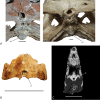A juvenile subfossil crocodylian from Anjohibe Cave, Northwestern Madagascar
- PMID: 27672490
- PMCID: PMC5028775
- DOI: 10.7717/peerj.2296
A juvenile subfossil crocodylian from Anjohibe Cave, Northwestern Madagascar
Abstract
Madagascar's subfossil record preserves a diverse community of animals including elephant birds, pygmy hippopotamus, giant lemurs, turtles, crocodiles, bats, rodents, and carnivorans. These fossil accumulations give us a window into the island's past from 80,000 years ago to a mere few hundred years ago, recording the extinction of some groups and the persistence of others. The crocodylian subfossil record is limited to two taxa, Voay robustus and Crocodylus niloticus, found at sites distributed throughout the island. V. robustus is extinct while C. niloticus is still found on the island today, but whether these two species overlapped temporally, or if Voay was driven to extinction by competing with Crocodylus remains unknown. While their size and presumed behavior was similar to each other, nearly nothing is known about the growth and development of Voay, as the overwhelming majority of fossil specimens represent mature adult individuals. Here we describe a nearly complete juvenile crocodylian specimen from Anjohibe Cave, northwestern Madagascar. The specimen is referred to Crocodylus based on the presence of caviconchal recesses on the medial wall of the maxillae, and to C. niloticus based on the presence of an oval shaped internal choana, lack of rostral ornamentation and a long narrow snout. However, as there are currently no described juvenile specimens of Voay robustus, it is important to recognize that some of the defining characteristics of that genus may have changed through ontogeny. Elements include a nearly complete skull and many postcranial elements (cervical, thoracic, sacral, and caudal vertebrae, pectoral elements, pelvic elements, forelimb and hindlimb elements, osteoderms). Crocodylus niloticus currently inhabits Madagascar but is locally extinct from this particular region; radiometric dating indicates an age of ∼460-310 years before present (BP). This specimen clearly represents a juvenile based on the extremely small size and open sutures/detached neural arches; total body length is estimated to be ∼1.1 m (modern adults of this species range from ∼4-6 m). This fossil represents the only juvenile subfossil crocodylian specimen reported from Madagascar.
Keywords: Anjohibe Cave; Crocodylus niloticus; Holocene; Madagascar; Pleistocene; Subfossil; Voay robustus.
Conflict of interest statement
The authors declare there are no competing interests.
Figures












References
-
- Bickelmann C, Klein N. The late Pleistocene horned crocodile Voay robustus (Grandidier & Vaillant, 1872) from Madagascar in the Museum für Naturkunde Berlin. Fossil Record. 2009;12(1):13–21. doi: 10.5194/fr-12-13-2009. - DOI
-
- Brazaitis P. The identification of living crocodilians. Zoologica. 1973;59:59–88.
-
- Brochu CA. Closure of neurocentral sutures during crocodilian ontogeny: implications for maturity assessment in fossil archosaurs. Journal of Vertebrate Paleontology. 1996;16(1):49–62. doi: 10.1080/02724634.1996.10011283. - DOI
LinkOut - more resources
Full Text Sources
Other Literature Sources
Miscellaneous

